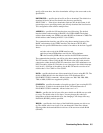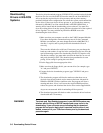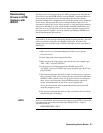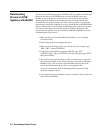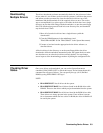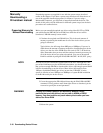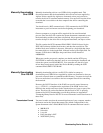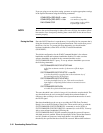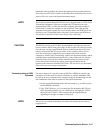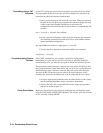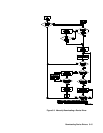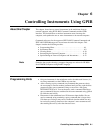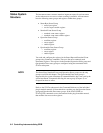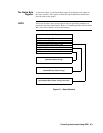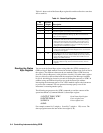
handshake mode is enabled, the System Instrument will not transmit characters
when either the CTS (Clear to Send) or the DSR (Data Set Ready) lines are not
asserted. This acts to pace the System Instrument output.
NOTE The E1405 Command Module RS-232 interface is implemented as a DTE (Data
Terminating Equipment). Since most computer RS-232 interfaces are also
implemented as DTEs, a cable that does line swapping (null modem cable) is
usually used to connect the computer to the instrument. This cable typically
swaps the receive and transmit lines. It will usually connect the DTR line of one
interface to the CTS and DSR lines of the other. It will connect the RTS line of
one interface to the DCD (Data Carrier Detect) line of the other.
CAUTION The RS-232 interface of the E1405 Command Module will echo any characters
received with an ASCII value greater than 32 and less than 128. Carriage returns
are echoed as carriage return/linefeed. When transferring the driver file, these
echoes can fill up the RS-232 receive buffer of your computer if they are not
read. If receive pacing is enabled for your computer this could cause the
computer to send the "Stop Transmitting" signal to the System Instrument, which
could block the remaining downloaded bytes or other commands sent after the
download. Since the driver file contains command strings and many carriage
returns that will be echoed by the system, your program should read the
returning echo characters from the RS-232 line. This will also let you determine
if there are any error messages coming back.
Transmitting Using a COPY
Command
On some computers it is possible to use an RS-232 or GPIB port and the copy
command to transfer the device driver. Hardware or software handshake must
be used by the copy command on the computer doing the downloading, and the
same handshake mode must be enabled on the System Instrument.
1. Set the required handshake mode and data format (e.g., on DOS systems
use the MODE command).
2. Type "COPY filename port" to transfer the file through the RS-232 port
to the System Instrument (e.g., on a DOS system you might use "COPY
/B filename.DC COM1:"). This command may be slightly different
depending on the type of computer being used.
NOTE Since errors are echoed immediately, this method of transfer has no means of
trapping errors.
Downloading Device Drivers 5-13



